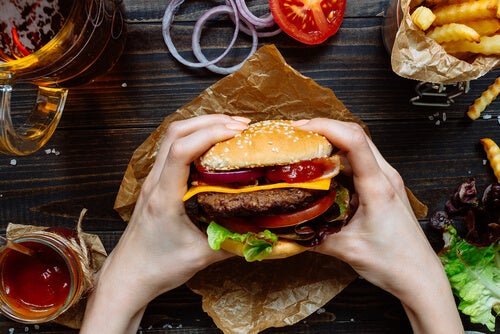Obesogenic Environments Promote Obesity


Written and verified by the psychologist Cristina Roda Rivera
Obesogenic environments are understood as the kinds that generate obesity. In other words, the kinds that increase the chances that the population will gain weight and suffer from chronic diseases. In effect, they’re any environments in which sedentary lifestyles are chosen over those that involve physical activity. Also, those, where, instead of eating to regulate sensations of hunger and satiety, people overeat. Moreover, unhealthy eating takes precedence over healthier foods.
It was Boyd Swinburn who gave this particular context meaning. The obesogenic environment is found mainly in large grocery stores where most of the population buys. Deals and discounts are often given on off-the-shelf products, while premium products are increasingly prized commodities.
On any given day, we may see a low-quality ‘something approaching food’ menu offered for the same price as a single vegetable. However, we shouldn’t fool ourselves. An obesogenic environment has the same impact on the diet of thin or normal-weight people. In fact, some people with a healthy and balanced diet have a higher body mass index (BMI) than others who follow unhealthy diets.
The aisles of these supermarkets, as Julio Basulto states in his book, Come Mierda (Eat Shit) generate food deserts, swamps, or ambushes that culminate in the obesogenic and pathogenic environment.

Nutritionists and psychologists on alert: the obesogenic and pathogenic environment
Today, the proportion of healthy food we see around us is extremely small. On the other hand, the sizes of the portions we’re offered are growing in parallel with our waist sizes.
Moreover, the food scene today is made up of an abundance of pastries in all shapes, sizes, and colors, high-sugar desserts, and french fries. These foods are marketed in a lighthearted kind of way that tends to be linked with bright colors. This overshadows public health and causes young people to normalize the kinds of foods that should only ever be seen as occasional treats.
Obesogenic environments and mental health
With the amount of hypercaloric foods on offer, the meaning of nutrition, fun, and pleasure has become distorted. In fact, it’s become complicated to eat well. In addition, physical overeating also leads to emotional overeating. This manifests itself in a series of eating disorders.
Snacking
Snacking is frequent in today’s world. We eat when we’re sitting in front of the tv at the end of the day, encouraged by the ads telling us to try one of their latest mass-produced artificially flavored bags of chips.
We also eat when we feel bad or lacking in something and realize that our lives are sad and devoid of emotion and ‘sensual pleasure’. Indeed, we snack and instantly savor what’s been sold to us as ‘good living and good eating’, hoping that we won’t suffer the negative effects.
If we try and eat healthier, our friends tell us we’re obsessed. That’s how we fall into the trap of snacking. Trying to say no is like refusing drugs in an environment where everyone else is consuming them.
Anxiety
Craving is an overwhelming feeling of hunger. However, it’s only related to specific foods that we like, and the craving ends once our hunger has subsided. We don’t live with continuing feelings of guilt, as a bulimia sufferer would experience.
The most common craving is for sweet things. It especially affects young women. It’s often accompanied by a general feeling of malaise, dizziness, and tiredness. It often also corresponds to a drop in blood glucose, which can be caused by an overly restrictive diet. However, there are also instances where this drop doesn’t occur.
Responding to cravings by gobbling up cakes or sausages at full speed is like taking a shot of sugar or serotonin, the neurotransmitter in the brain that increases after we ingest large amounts of sugary substances. In the very short term, it makes us feel good.
Chocoholics
Many of us adore chocolate. The problem lies with the kind of chocolate we’re sold, not the cocoa. However, 90 percent of chocolate lovers are happier with the kind of chocolate that contains more milk, sugar, or biscuit. Also, chocolate is often associated with happy childhood memories.
The fat and sugar in chocolate increase the release of serotonin. In addition, chocolate increases the levels of endorphins, the morphine that our brains produce naturally when we perform certain activities, such as playing sports. Chocolate also contains anandamide. This is a type of endocannabinoid that has relaxing effects on our nervous systems.
Night eating syndrome
Getting up in the middle of the night to eat a large amount of food is the main sign of night-eating syndrome (NES). This uncontrolled eating is usually motivated by anxiety.
The condition can have serious health consequences. Those who suffer from it usually postpone the first meal of the day for several hours and eat fewer calories during the day.

Hyperphagia
This eating behavior is characterized by a regular excess, both in the amount of food on the plate and in the way it’s put into the mouth. For instance, large spoonfuls, quick bites, or brief chewing. It may be a family trait.
Sometimes, hyperphagia becomes pathological, resulting in bulimic hyperphagia, a recently classified illness. With this disorder, the sufferer can’t stop eating. However, it doesn’t present the same numbing nature or programming typical of the bulimic crisis.
The worst way to combat the obesogenic environment
The more stigma and responsibility that’s placed on the behavior of obese people, the less will fall on the companies that manufacture products of extremely low nutritional quality to alter the reward circuits in our brains. We need to recognize that many of the well-known people who advertise these products never really consume what they promote. For them, it’s just a job.
What can we do to stop it all? To start with, we can start listening to scientists without commercial interests in the food industry. We can also stop listening to the multinationals that have to lie about their products in order to sell them. Depending on what path we choose, our populations will, at increasingly earlier ages, either have improved or damaged health. It’s up to us to decide.
All cited sources were thoroughly reviewed by our team to ensure their quality, reliability, currency, and validity. The bibliography of this article was considered reliable and of academic or scientific accuracy.
- Ellenberg, C., Verdi, B., Ferri, C., Marcano, Y., & Vivas de Vega, J. (2006). Síndrome de comedor nocturno: un nuevo trastorno de la conducta alimentaria. In Anales Venezolanos de Nutrición (Vol. 19, No. 1, pp. 32-37). Fundación Bengoa.
- García, A. M. (2020). Ambiente obesogénico: barreras para mantener un peso saludable (Doctoral dissertation, Universitat d’Alacant-Universidad de Alicante).
- Villagrán, M., Petermann-Rocha, F., Martínez-Sanguinetti, M. A., & Celis-Morales, C. (2019). La interacción de nuestros genes con el ambiente obesogénico. Revista médica de Chile, 147(11), 1493-1494.
This text is provided for informational purposes only and does not replace consultation with a professional. If in doubt, consult your specialist.








